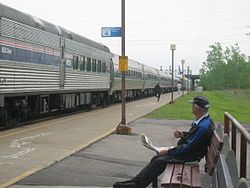Rail Series: Who will own it? Who will pay for it?
by CalWatchdog Staff | December 18, 2012 1:32 am
 [1]This is Part 6 of a series on Medium-Speed rail alternatives to California’s High-Speed Rail project. Click to read Part 1[2], Part 2[3], Part 3[4], Part 4[5], and Part 5[6].
[1]This is Part 6 of a series on Medium-Speed rail alternatives to California’s High-Speed Rail project. Click to read Part 1[2], Part 2[3], Part 3[4], Part 4[5], and Part 5[6].
Dec. 18, 2012
By Stan Brin
In any discussion of rail expansion, two gorillas always appear: How do we pay for it? How do we keep the government out of it?
I’m not a politician. I can only accept that the people of California, especially in the areas that would be served by faster rail service, have spoken. They want it and appear ready to pay for it. They were simply sold a technically impossible can of worms at a ridiculous price.
Here comes the hard part: Private enterprise isn’t interested, at least not in financing it.
In fact, railroad companies, often willing to go to heroic lengths to improve their freight traffic, feel about passenger service the way most people feel about disease-bearing insects. It’s death.
Overregulation and price manipulation by the now-defunct Interstate Commerce Commission[7] nearly wiped them out.
While the federal regulators that kept fares low and unprofitable lines open have been abolished, I don’t see anyone stepping in to invest his own money. So if the taxpayers want trains, they will have to pay for them out of the public purse, the way Louis XIV financed the Canal du Midi[8].
Who is to own it?
As planned, the High-Speed Rail project is to be an independent, state-owned system operating entirely on its own.
My alternative, on the other hand, would be mostly a modernization of existing routes — the Tehachapi segment being the exception — and a part of the national railroad system. The track owners are likely to be the companies that own the existing right of way, Union Pacific and BNSF, or a combination of the two — or a consortium along the lines of the Alameda Corridor agency.
Perhaps a new company will operate the trains that will run on the new tracks, but perhaps no one but Amtrak (sigh) will want to operate it.
There is no question that Amtrak loses money on every line it runs. There is no question that Amtrak could probably break even on its East Coast “sorta high speed” Acela Express[9] line if politics didn’t intercede to keep fares about five bucks per ticket below cost.
There is also no question that its long distance routes across the prairies and deserts can never break even because the ridership isn’t there. Political pressure keeps those lines rolling.
A divested Amtrak would face the same issues.
I believe that that Amtrak can be divested, but Congress would likely force the private operator or operators to maintain unprofitable lines, and the private operators, in turn, would expect federal subsidies to do so, bringing us back to square one.
In fact, it’s hard to find a precedent for this problem. The British divested their state-owned trains in the 1990s, and created a bloody mess which they still haven’t been able to clean up. Even Richard Branson couldn’t make a go of it. His Virgin Rail Group system and was about to lose his franchise until it was extended until November 14[10]. After that, it’s uncertain what will happen.
The Federal Government successfully divested its cobbled-together Conrail [11]system in the 1980s, but its assets were undervalued and the taxpayers were taken to the cleaners. The two private railroads that snapped up Conrail made a fortune.
France
Perhaps the whole thing should just be turned over to the French. Against all logic, their TGV trains make a profit of a billion dollars a year, even if they can’t regularly run above 200 mph. The French also obtain 75 percent of their electricity from nuclear facilities, but have never had a major accident.
Go figure.
In 2010, the managers of the French high-speed rail system made some suggestions [12]to the California HSR authorities that they said would make the line profitable, but they were rudely ignored.
Perhaps someone thought such behavior was a form of payback — Americans being rude to the French, for a change.
Whatever the case, the French went home in a huff, and we’re stuck with a boondoggle. And certainly no one is going to pay any attention to all my talk about double-tracking.
Medium-Speed Rail?
It’s too easy, and too cheap.
Forget about it.
- [Image]: http://www.calwatchdog.com/2012/12/18/rail-series-who-will-own-it-who-will-pay-for-it/amtrak-wikipedia/
- Part 1: http://www.calwatchdog.com/2012/12/10/railroad-series-medium-speed-rail-runs-over-high-speed-rail/
- Part 2: http://www.calwatchdog.com/2012/12/12/rail-series-a-capitalist-solution-for-california-train-travel/
- Part 3: http://www.calwatchdog.com/2012/12/13/rail-series-single-track-bottleneck-slows-ca-trains/
- Part 4: http://www.calwatchdog.com/2012/12/14/rail-series-medium-speed-train-tracking-costs-less-than-high-speed-rail/
- Part 5: http://www.calwatchdog.com/2012/12/17/rail-series-surmounting-the-tehachapi-barrier/
- Interstate Commerce Commission: http://en.wikipedia.org/wiki/Interstate_Commerce_Commission
- financed the Canal du Midi: http://www.calwatchdog.com/2012/12/12/rail-series-a-capitalist-solution-for-california-train-travel/
- Acela Express: http://www.amtrak.com/acela-express-train
- extended until November 14: http://en.wikipedia.org/wiki/Virgin_Trains
- Conrail : http://en.wikipedia.org/wiki/Conrail
- made some suggestions : http://www.joplinglobe.com/national/x694485136/California-high-speed-rail-officials-rebuffed-proposal-from-French-railway
Source URL: https://calwatchdog.com/2012/12/18/rail-series-who-will-own-it-who-will-pay-for-it/